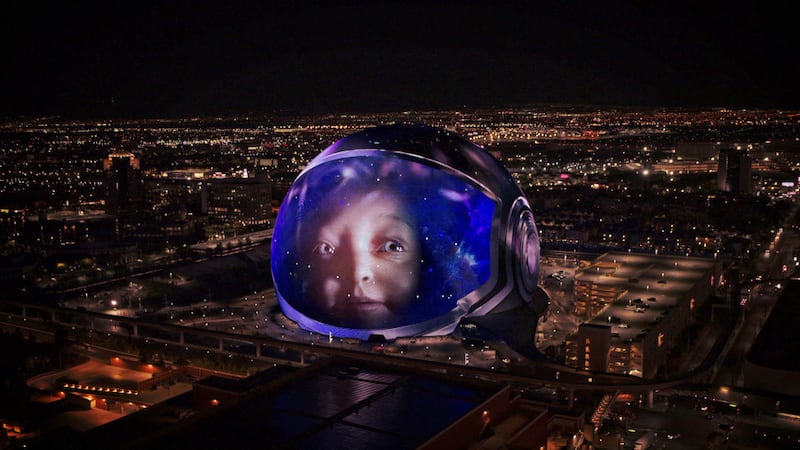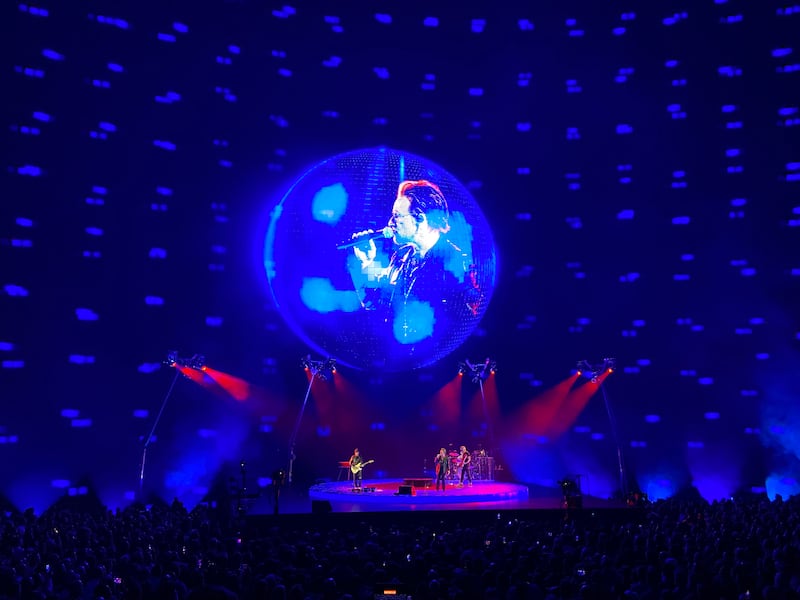Even those who have never been to Las Vegas know it by reputation – and it’s a reputation that continues to be deserved. From the slot machines at the airport to the huge billboards advertising the residencies of megastars, Vegas is easily as flashy as the most extravagant of claims that are made for it.
Take our hotel, the Luxor. Its exterior features a 32-metre-high recreation of the Great Sphinx of Giza. It is shaped like a pyramid. It’s 30 storeys high, it has more than 4,400 rooms and it looks almost commonplace in the glitzy, neon-clad landscape. At the New York–New York hotel and casino, the Big Apple rollercoaster winds its way around the edifice. At the Paris Las Vegas Casino Hotel, there are replicas of the Eiffel Tower, the Louvre, the Paris Opera House, and the Musée d’Orsay.
The Venetian hotel and casino, meanwhile, includes a recreation of St Mark’s Square and a replica of Venice’s grand canal that weaves its way through the hotel. When the venue was opened in 1999, then Venice mayor, philosopher and intellectual Massimo Cacciari, described The Venetian as “a mega-galactic example of kitsch.” Welcome to Las Vegas, baby.
We are here for a full five days, the primary purpose of which is to see U2 play one of their final shows at the city’s latest brightly-lit tourist attractions, Sphere.
RM Block
As we approach the landing strip of the Harry Reid International Airport we can see Sphere from the aisle seat. It sits like a gigantic Christmas tree bauble amid other gaudy structures and, therefore, fits in perfectly with the Vegas vibe of “big is better”.
The “bigness” of the city, which has a metropolitan population of more than 2,200,000, is partially why it styles itself as being the entertainment capital of the world. You can list off the attributes until you’re weary of them, but the main ones include being a global leader in the hospitality industry, its ranking as one of the world’s most visited tourist destinations, its tolerance for numerous forms of adult diversions (aka Sin City), and its globe-beating reputation for gambling (it boasts the world’s largest number of land-based casinos).
The gaming part will hit you the moment you walk out of your Uber and into your hotel. Unless you are lucky enough to be staying at the elegant Waldorf Astoria (which has a no-gaming policy), your hotel will feature an interior landscape of gambling machines. The high register ping-ping-pings bursting from the banks of equipment specifically designed to take your money will become a soundtrack for most of the remainder of your stay and will, if you can’t drown them out, give you a headache.
Not only that, but as you walk towards the registration desk, you notice for the first time in many years the almost forgotten aroma of confined cigarette smoke: all operational casinos allow players to smoke (and if they’re actively playing, free drinks are supplied).


Call us ridiculously sensible, but gambling isn’t what we’re here for, and judging by the generally morose demeanour of virtually everyone that we walked by on a daily basis, in several casinos, it isn’t their thing, either – yet many take up the challenge.
But that’s part of the experience of Las Vegas: it offers a different cultural climate by which to live in, and if some or many hours are passed in the flawed expectation of hitting the big time, then so be it. Who cares if the odds are stacked against you, when you have optimism on your side?
Speaking of which, after U2′s triumphant, visually extraordinary show at Sphere (the band conclude their residency at the venue this weekend) we have four full days to see what we hope is another side of the city.


We are advised to check out “Old” or “Downtown” Las Vegas, which was the original hub of immorality before the Rat Pack and Hollywood came along and settled almost 10km south at the Strip. Come the 1930s, with the re-legalisation of gambling, the final years of prohibition, the emergence of Mafia figures, and the completion of the Hoover Dam, an area called Fremont Street became the focus of attention.
With the dam’s hydroelectricity surge powering all of those neon signs, and with casinos opening to cater to a population that increased from 5,000 to about 25,000, a reputation for good times was born.
Today, Fremont Street (or the ‘Fremont Street Experience’, as the tourist boards call it) is a six-block, pedestrian-only blaze of colour. To say it’s noisy and crammed with people having the time of their lives is an understatement. Even this risk-averse writer is persuaded to enjoy an overhead zip line trip across the length of the street.
Outdoor bars heave with partygoers, street performers tumble onto the sidewalks, while inside the casino bars, it’s a pick ‘n’ mix of smoke, booze, go-go dancers on tables, gamblers and dodgy-looking characters.

So far, so unexpected, but there’s more to Las Vegas than its Sin City sobriquet.
Located in the Downtown area, the outdoor Neon Museum is a unique experience. It began in the mid-1990s as a storage home for inoperative and/or discarded neon signs rescued from 200 Las Vegas properties and is now a functioning (and sparkly) treasure chest of mostly fully repaired items, each of which tells their story.
Also in the Downtown area is the Mob Museum, the task of which is to outline how organised crime emerged and the impact it has had on American society. From archival historical footage and hands-on exhibits to guided tours and numerous displays (one of which is a verified section of the brick wall where the 1929 St. Valentine’s Day Massacre took place – bullet holes included), the experience is enough to drive you to drink, which is exactly what we do on our final afternoon and evening.
The Petrossian Piano Bar at The Bellagio is world-renowned, and rightly so; there may be a hint of hustle and bustle in the lobby, but there is also a ceiling adorned with Dale Chihuly’s glass sculpture, Fiori di Como, a gifted pianist playing Clair de Lune, a negroni (for her) and a brandy alexander (for moi). It is, you might say, a moment.

The next stop is the nearby Waldorf Astoria and its Skybar, which is not a traditional hotel bar, but rather a destination in its own right. The space is the personification of designer chic, and the view across the Strip skyline is, as you might imagine, breathtaking: it’s kaleidoscopic and a bit of a head-spinner.
And that’s it – we’re done and dusted and worn out. We all know the cliche about what happens in Vegas stays in Vegas, but I’m here to tell you that we had a blast, a ball, and a barrel full of bleary-eyed, Sphere-shaped fun. Beyond that, I’m saying nothing.
Las Vegas: A practical guide
Ubers: We took Ubers everywhere we went. Cheaper than taxis, and accessed with ease from the Uber app, the average cost of trips – be they from one end of the 6km Strip to the next, to Downtown Vegas, or to the nearby outlet shopping malls – was around $14. If you’re getting an Uber from any hotel, however, be sure to first locate the “ride and share” and/or “parking garage” area, which are usually at a rear entrance, and at which Ubers drop off and pick up.
Service: I don’t think I’ve ever been called “sir” so often, such are the unfamiliar levels of courtesy from restaurant/cafe servers, bar staff, Uber drivers, and people in general. This is very much an American retail/tourist industry trait but is something you are soon deprived of when you return home.
Tips: You might fairly guess that the tipping culture here is part of the reason why people are so nice to you. For every visit to a cafe, restaurant, and bar, and for every Uber we took, we added a tip – usually either 10 or 15 per cent. On more than one occasion, we were reminded firmly (albeit with a fixed smile) that a tip would “very much be appreciated, sir.” Budget accordingly.





















